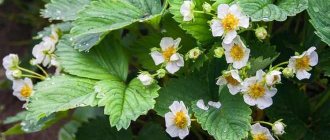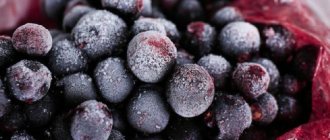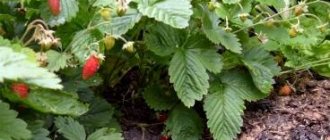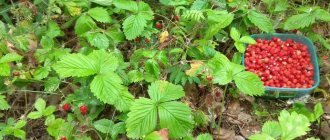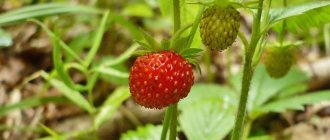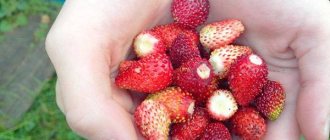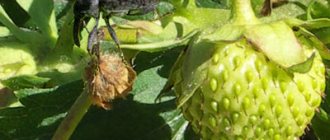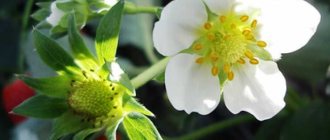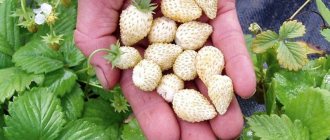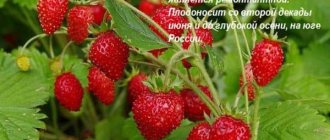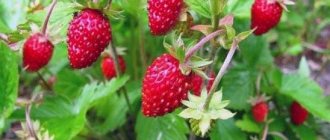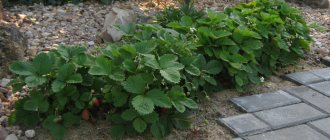Description
Ali Baba strawberry is a remontant and high-yielding variety. The plant bears fruit from June until the onset of frost. Gardeners collect up to 0.4-0.5 kg of aromatic berries from one bush throughout the summer. And from ten roots - 0.3 kg of fruit every 3-4 days.
The plant has a spreading and powerful bush that can grow up to 16-18 cm in height. It is abundantly covered with dark green foliage. Even in the first year of fruiting, many white inflorescences are formed. A distinctive feature of the variety is that strawberries do not form mustaches.
Ali Baba strawberries bear small bright red berries, the average weight of which varies between 6-8 grams. The shape of the fruit is conical. The pulp is tender and juicy, milky in color. The bones are small, so you can't feel them. The berries have a sweet and sour taste and an alluring aroma of wild strawberries. This is an unpretentious variety that tolerates drought and cold well.
Advantages and disadvantages
According to reviews from gardeners, a number of advantages and disadvantages of Ali Baba strawberries can be identified. They are presented in more detail in the table.
| pros | Minuses |
| Abundant Harvest | It does not produce a mustache, so this variety can only be propagated by dividing the bush or by seeds |
| Continuous and long-term fruiting | Fresh berries can be stored for only a few days. Therefore, after collection, it is advisable to immediately eat or process them. |
| Delicious, aromatic fruits of universal use | Low transportability |
| Tolerates lack of moisture and soil freezing well | Every two to three years it is recommended to rejuvenate the plantation. Otherwise, the quality of the berries will deteriorate and the yield will decrease significantly. |
| Resistant to fungal diseases and rarely affected by pests | |
| The plant begins to bear fruit in the first year after planting in the garden. | |
| This berry variety can be grown in a pot as an ornamental plant. | |
| Unpretentiousness to the soil. Can grow in any climate conditions |
The Ali Baba strawberry variety is ideal for home growing. To preserve the berries for a long time, they are frozen. You can also make various jams and preserves from them, and add them to baked goods.
a brief description of
Advantages of the variety
- high productivity;
- continuous fruiting until the cold weather;
- tasty, tender, fragrant fruits;
- high resistance to drought;
- winter hardiness;
- immunity to many diseases, almost not affected by insect pests;
- gives a harvest in the first year after planting;
- undemanding to the composition of the soil;
- grows in any climatic region of Russia;
- City dwellers appreciate this variety for its ability to grow indoors.
Disadvantages of the variety
- impossibility of long-term storage and transportation;
- after 3-4 years it is necessary to start the plantation again, since the yield of old bushes decreases sharply;
- Reproduction is possible only by dividing the bush or by seeds.
It is this last drawback that is the reason that not all gardeners undertake to grow beardless remontant varieties.
Reproduction methods
Since this variety of strawberry does not form a mustache, it can only be propagated by seeds or by dividing the mother bush.
Dividing the bush
For plant propagation, the largest and most prolific specimens are selected. After harvesting, the bushes are dug up and carefully divided into several parts. Each of them should have at least 2-3 white roots. Plants with dark brown roots are not suitable. Some gardeners prefer to carry out the procedure in early spring. Then next year you will be able to reap a bountiful harvest.
Attention! Before planting, it is recommended to soak the seedlings in a solution of a root formation stimulator.
Growing from seeds
Anyone can grow Ali Baba strawberries from seeds; the main thing is to be patient and adhere to simple rules for growing seedlings.
Sowing of seeds is carried out at the end of January - early February. In case of insufficient lighting, the planting date is shifted to March. Before planting, the seeds must be treated. They can be sown both in boxes and in peat tablets. After the emergence of seedlings, picking is carried out.
Attention! A detailed description of growing strawberries from seeds.
Description of the variety
The magnificent strawberry Ali Baba was created by breeders from Holland. People who tried to develop the variety, or rather Hem Zaden developed it in 1995, tried to create a high-yielding variety of magnificent strawberries. Its small size allows you to grow the Ali Baba variety in flower pots.
Strawberry Ali Baba is a small-fruited remontant variety. In simple terms, remontant varieties are varieties that produce large yields in the first two years. They bear fruit from mid-June until the first frost. Late November – early December. Small strawberry bushes are very strong, but small in size, reminiscent of small flowers in flower pots.
The weight of one fruit is seven to eight grams, and the height is no more than fifteen to twenty centimeters. The taste is reminiscent of wild strawberries, with the same pronounced aftertaste and color/shape.
pros
Advantages of the Ali - Baba variety:
- This strawberry is more resistant to dry weather and diseases;
- Resistance during frosts (late November - early December);
- Huge yield - about ten kilograms in one season (for two years);
- Long period of fruitfulness;
- The sweetness of Ali Baba berries;
- Simple fruit care for the first two years;
- There is no break in the fruitfulness of the variety;
- The taste is more pronounced than other berries.
Flaws
- Ali Baba strawberry is not resistant to severe diseases;
- Ali Baba fruits are not recommended for transportation; they will simply be destroyed and turn into mush;
- After two years, it stops bearing fruit if it is not transplanted to another place or divided into separate bushes.
Difference between wild strawberries and strawberries:
- The shape of flower petals and their size;
- Stem height (strawberries - from thirty to thirty-four centimeters, and strawberries from nineteen to twenty-four centimeters);
- Leaves (strawberry leaves are light green or corrugated);
- Harvest (strawberries produce more berries than their counterparts);
- Aroma (strawberries have a much more pronounced smell);
- Fruit size - strawberries are much smaller and more elongated;
- Strawberries are distinguished by their juiciness and excellent taste, striking all taste buds.
In order to grow Ali Baba strawberries, you don’t need a lot of intelligence, just like a lot of effort. The most important thing is to reserve a lot of restraint, patience and maintaining the rules of planting and seeds. It is very important to follow all these rules in order to get bright and tasty berries.
Landing
Ali Baba is an unpretentious variety to grow. But in order for strawberries to bear fruit continuously throughout the season and for the berries to be sweet, it is necessary to observe the specifics of agricultural technology.
Attention! More detailed information about planting berries.
How to choose seedlings
Purchase Ali Baba strawberry seedlings only from certified nurseries or trusted sellers. When purchasing seedlings, pay attention to the following points:
- By the end of May, the plant should have at least 6 green leaves. If dark and light spots of varying sizes are noticeable on the foliage, most likely the strawberries are infected with a fungus. Also, do not take seedlings with pale and wrinkled leaves.
- Check the condition of the horns. They should be juicy and pale green in color. The thicker the horn, the better.
- The root system must be branched and at least 7 cm long. If the seedling is in a peat tablet, the roots must extend out.
Only by following simple recommendations can you choose high-quality seedlings.
Site selection and soil preparation
Strawberries of this variety feel comfortable in sunny areas with a flat surface. You cannot plant it in lowlands, as the plant does not like dampness. If groundwater is close, prepare high beds or ridges. The best predecessors of Ali Baba strawberries are legumes, garlic, clover, buckwheat, sorrel, and rye. Every three years the plant needs to be replanted to a new location.
Strawberries prefer nutritious soil with a neutral or slightly alkaline environment. If the soil is acidic, dolomite flour is added to it. For each square meter of bed add 2-3 buckets of humus, two tablespoons of superphosphate and 1 tbsp. l. potassium and ammonium nitrate. Then the soil is carefully dug up.
Important! To plant this crop, you cannot use beds in which tomatoes or potatoes grew.
Planting scheme
Ali Baba strawberry seedlings should not be planted too close, as over time they will grow greatly. To make the plant comfortable, the bushes are planted at intervals of at least 35-40 cm. There should be about 50-60 cm between the rows. At first it will seem that strawberries are planted sparsely, but after a year the rows will become denser.
Holes are dug in accordance with the planting pattern. The roots of the bush are straightened and lowered into the recess. Gently sprinkle with soil, lightly compact and water with 0.5 liters of water.
What is the difference between wild strawberries and strawberries?
Many gardeners are confused between the definitions of strawberries and wild strawberries, calling one the other. But there are also garden strawberries. The diversity of these concepts makes you wonder, what is the difference between them and what is what? Let's try to figure it out.
Strawberries, which we are accustomed to considering as a large bulk berry that takes on a variety of shapes, are actually a relative of wild strawberries, whose berries are small, elongated or round, fragrant and very sweet. Such bushes, once in a garden plot, grow rapidly, forming entire carpets. However, the yield of this crop is low, and only a few summer residents use it, who prefer to decorate part of their garden with greenery in this way.
But those large and juicy berries that can be found in any country house are garden strawberries. But few people remember this and call the berry by a name other than its own. And so long ago that it has already taken root in human consciousness and is unlikely to ever change. And finally, ordinary strawberries are a bush with fragrant small berries, a storehouse of vitamins and useful microelements. It would seem that the difference is only in the berries? No. There are certain differences in morphological characteristics such as the size of the leaves, the ability to grow whiskers, etc. But we focus on the most noticeable aspect, which can be easily noticed at first glance.
Photo gallery: comparison of strawberries and strawberries
Strawberries are distinguished by small berries, as if covered with velvet
Garden strawberry is a cultivated berry that reaches a weight of 50 grams
Fragrant and sweet strawberries are a decoration for any area
Care
Regular care guarantees long-term fruiting and healthy appearance of strawberries. Ali Baba needs loosening, weeding, watering, fertilizing and preparing for the winter.
Loosening and weeding
To provide the plant's roots with air, the soil around the plant must be loosened. It is recommended to perform this procedure before the strawberries ripen. The beds must be cleared of weeds, as they take nutrients from the ground. They are also hotbeds for the spread of diseases and pests. Old and dried strawberry leaves are removed along with the weeds.
Watering and mulching
Despite the fact that Ali Baba strawberries are drought-resistant, they need watering to produce sweet fruits. The first irrigation is carried out during the flowering period. On average, strawberries of this variety are watered once every 10-14 days. There should be about 1 liter of water per plant.
After watering, mulching is carried out. The row spacing is covered with a layer of dry sawdust, grass or straw.
Important! It is recommended to water the plant at the root or along the furrows.
It is undesirable to use the sprinkling method, since moisture on the surface of strawberries can contribute to rotting of the fruit.
Fertilizing
Ali Baba strawberries begin to be fertilized in the second year after planting. For this purpose, organic and mineral fertilizers are used. In total, about 3-4 procedures will be required. For root growth and rapid growth, nitrogen fertilizing is applied in early spring. During the formation of flower stalks and ripening of berries, the plant requires potassium and phosphorus. To store nutrients and enhance winter hardiness, phosphorus-potassium fertilizers and mullein are applied in the fall.
Attention! Read more about fertilizing for strawberries.
Preparing for winter
After harvesting, sanitary cleaning is carried out. To do this, damaged leaves are cut off and diseased plants are destroyed. Strawberries of the Ali Baba variety need shelter for the winter. The easiest option is to cover the bushes with dry spruce branches. As soon as snow falls, a snowdrift is collected on top of the spruce branches. Some gardeners make a wire frame over the bed and stretch film or agrofabric over it.
Attention! Read more about preparing strawberries for winter.
Planting and care
Site selection and soil preparation
Strawberries should grow in a sunny spot in the garden.
Choose a well-lit place for strawberries. At higher elevations, planting is done so that the bush is located on level ground. If the site is in a lowland, the procedure is performed on ridges or ridges. The most suitable predecessors for the plant: legumes, sorrel, garlic, mustard, soybeans, lentils, clover, rye, buckwheat.
Important! Strawberries cannot be planted in areas where tomatoes, physalis or potatoes previously grew.
To plant seeds, you need to prepare a soil mixture of 3 parts sand and 5 parts humus. The soil may contain various microorganisms that cause diseases of the root system.
To protect the plants, it is recommended to pre-steam the soil. To do this, the mixture is placed in an oven heated to 90°C–100°C for 3–4 hours. Planting can be started only after the soil has cooled.
Boarding pattern and time
Strawberry seedlings are planted in spring
Seeds are sown from February to April. It is important to follow the following rules:
- 2 weeks after the emergence of seedlings, the seedlings dive. That is, they are moved to other containers, keeping a distance of 2 cm between plants.
- When 4–5 leaves appear, you need to carry out the next picking. This time the distance between seedlings is increased to 5 cm.
- After the formation of 6 leaves, the plant is transplanted into open ground. The space between rows should be 25–30 cm, between bushes - 20 cm.
Watering and fertilizing
Watering and fertilizing contribute to a good harvest
You should start watering strawberries after flowering begins. Until this time, a sufficient level of moisture remains in the soil after winter.
Table: irrigation scheme
| Watering frequency | Liquid volume | Watering method |
| Once every 10 days. | 20 liters of water per 1 sq.m. | Under the root. In the furrows. Drip irrigation. |
Important! You should not water strawberries using the sprinkling method, since excess moisture that gets onto the crop can cause rotting of the fruit.
They begin to feed strawberries in the second year of cultivation. For this purpose, both mineral and organic substances are used. Potassium, superphosphate and saltpeter are added to the plant. For 10 sq.m. plot will require 50 g of each substance. To prepare organic fertilizer, you need to dilute mullein in water in a ratio of 1:5 or bird droppings in a ratio of 1:15. Fertilizing is applied according to a certain scheme.
Table: feeding scheme for Ali Baba
| Application of organic fertilizers | Application of mineral fertilizers |
| After the snow melts | In March–April |
| During the formation of peduncles | After fruiting |
| During flowering | |
| After harvesting the fruits |
What else do you need to know about growing strawberries?
Strawberries need to be hilled and insulated for the winter
One of the stages of caring for strawberries is mulching. This procedure prevents the evaporation of moisture from the soil, improves its composition and prevents the growth of weeds. The soil is covered with a 10 cm thick layer of sawdust, straw or grass. To provide the root system with air and remove weeds, it is recommended to loosen the soil between the rows.
Strawberries are weeded three times until the berries ripen. It is not advisable to loosen the soil during fruiting. Along with the weeds, old reddened leaves are also removed, this helps to rejuvenate the bushes.
Before the winter period, the ground around the plant is hilled up and mulched. Snow cover is a good heat insulator: it protects the soil from freezing. During snowless winters, strawberries need to be covered. Hay, straw or leaves work well. These materials are the most affordable, but have some disadvantages. They accumulate moisture, cake, and in the spring they are difficult to separate from the bushes. With frequent thaws, plants may die under such cover. Therefore, to protect strawberries, it is recommended to use spruce branches, dry raspberry branches or brushwood.
You can also use agrotex material. It is stretched onto arcs, which are installed above the bushes in the fall. Agrotex allows moisture and light to pass through and reduces temperature fluctuations.
Diseases and control methods
This berry variety is highly resistant to various diseases. But if you do not take care of the plant, bushes and berries can be affected by late blight, white spot and gray rot.
The table provides a description of typical diseases of strawberries of the Ali Baba variety.
| Disease | Signs | Fighting methods |
| Late blight | Dark spots and white bloom appear on the berries. The roots rot and the fruits shrink and dry out. | The diseased bush is removed from the garden bed and burned |
| White spot | Brown spots form on the foliage. Over time, they turn white and acquire a dark red edging. | Spraying the aboveground part of the plant with Bordeaux mixture. Removing infected leaves. |
| Gray rot | Dark spots appear on the leaves, and a gray coating appears on the fruits | Treating bushes with Bordeaux mixture and removing dry leaves |
Attention! Read more about strawberry diseases.
Rules and important features of strawberry propagation
Strawberry Ali Baba can be propagated by bush or seeds
Strawberries of the Ali Baba variety can reproduce only in two ways:
- dividing the bush;
- seeds.
Growing by seeds
The seed method is labor-intensive, but gives good results
Seeds are collected from the largest and healthiest berries. You can get them in two ways. The first involves the following actions:
- The top layer of skin is cut off from the fruit using a blade.
- Planting material is laid out on paper and dried for several days in the sun.
- Then the mass is ground to separate the seeds from the pulp. Store them at room temperature in paper bags.
Important! Seeds can be separated from the pulp using water. Properly prepared material is suitable for use for 3–4 years.
Before sowing, the prepared seeds are soaked in water for 6 hours. For planting, you will need boxes or containers measuring 10x30x50 cm. Otherwise, the process has the following features:
- A drainage made of broken bricks is placed at the bottom of the container so that it occupies 1/3 of the total volume.
- Then the box is filled with a soil mixture consisting of sand and humus in a 50/50 ratio.
- The soil is moistened and sowing begins. The distance between rows should be 5 cm.
- The seeds are very small, so they are buried to a maximum of 0.5 mm.
- The boxes are covered with glass until the first shoots appear.
Shoots will appear in 30 days. To speed up seed germination, the box can be covered with polyethylene and placed in the refrigerator for 2-3 days. After this, the container should be placed in a room with a temperature of 22 ° C–25 ° C.
There is another way to plant seeds. Its features are as follows:
- First, the seeds are soaked for 6 hours. Filtered paper is placed on a saucer, planting material is laid out on it, placed in a plastic bag and placed in a well-lit, warm place.
Important! Direct sunlight should not fall on the bag of seeds.
- When the seeds have roots, they are transplanted into boxes using a mixture of humus and sand (1:1 ratio).
Video: features of seed propagation
Seedling method
A healthy adult strawberry bush is divided into several parts
The seedling method is considered the simplest. An adult strawberry bush can be divided into any number of parts. The main thing is that each of them has at least 2 healthy roots. The best time for the procedure is late spring-early autumn. During frosts, the roots can be severely damaged and the bush will not take root.
Important! Leaves must be removed from the cuttings.
To plant, holes are first dug in the area. Their depth should correspond to the size of the root system. A mixture of 1 kg of humus and 50 g of granulated superphosphate is poured into the holes. The bush is placed in a hole. In this case, you need to ensure that the roots are well straightened and not bent. The holes are filled with soil and compacted around the bush. After planting, each plant is watered with 0.5 liters of water.
Important! It is recommended to choose cloudy weather for transplanting strawberries.
Video: seedling method (dividing a bush)
Pests and ways to combat them
The table shows the main pests of strawberries of the Ali Baba variety.
| Pest | Signs | Fighting methods |
| Slug | Holes are visible on leaves and berries | Spraying with superphosphate or lime |
| Spider mite | Cobwebs appear on the bushes, and the leaves turn yellow. In some places you can see white dots | The use of anometrine and karbofos. Removing Infected Foliage |
| Leaf beetle | Presence of oviposition | Treatment with lepidocide or karbofos |
Attention! More detailed information about strawberry pests.
How to deal with pests and diseases
Ali Baba rarely gets sick, the variety is practically not afraid of pests. However, under unfavorable weather conditions or improper care, this variety of remontant strawberry can be susceptible to trouble.
Table: signs of damage and control measures
| Diseases/pests | Signs of defeat | Control measures and prevention |
| Strawberry transparent mite | Affects young strawberry leaves. Over time, the leaves wrinkle, turn yellow and die. |
|
| Various spots | The leaves become stained and the berries rot. |
|
Photo gallery: how to recognize diseases and pests
Brown spot on strawberry leaves
This is what a strawberry transparent mite looks like
Strawberry white spot
Features of growing in pots
This variety of strawberries can be grown in pots on a loggia or windowsill. In this case, it will bear fruit all year. For planting, choose a container with a volume of 5-10 liters and a diameter of at least 18-20 cm. Drainage is poured to the bottom, and nutritious soil is laid out on it. In winter, additional lighting is needed. The more light, the better the quality of the berry. For better pollination, the bush is shaken periodically.
How to distinguish garden strawberries from strawberries?
Some gardeners are alarmed by the phrase remontant strawberry: strawberries are small berries, and it is more profitable and more common to grow strawberries, they believe. This opinion is widespread, but that does not stop it from being erroneous. If among the bushes of the berry crop you grow there are both female and non-fruit-bearing plants that perform only the function of pollination, if its fruits have a conical shape, purple color and a strong nutmeg flavor, then you probably belong to a rare group of gardeners in our country growing strawberries. Another significant difference between strawberries and strawberries is the location of the peduncles: in strawberries they are located above the foliage, and in strawberries, on the contrary, below. Strawberries are currently not in the best position - almost everywhere they have been crowded out of gardens and vegetable gardens by garden strawberries.
Harvest and storage
Ali Baba strawberries begin to ripen earlier than large-fruited varieties. Berries must be picked as the fruits ripen, at least once every 2–3 days . When harvesting, do not remove the pink berries - they are still growing and can increase significantly in size, and their taste also improves as they ripen.
If you want to stimulate not spring, but subsequent fruiting, you can use a little trick: by removing spring flower stalks, you will direct all the nutrients to the formation of the second and subsequent harvests.
Strawberries are harvested at least once every three days
Due to their biological characteristics, strawberries cannot withstand long-term storage. At a temperature of 0°C it is stored for 6 to 8 days, and at 6°C - only a day.
Agricultural technology
Propagation of berries is possible in two ways: seeds and dividing the bush.
Strawberry Ruyana - description of the variety
To collect grains, you need to choose juicy and large fruits. The skin with seeds is cut off with a sharp knife, dried and rubbed in hands until only a few grains remain. If everything is done correctly, they can be stored for up to 4 years. Sowing is done from February to March. The seeds are mixed with sand and distributed evenly over the ground. Watering must be done by spraying. The seedlings are covered with glass. During this period, it is necessary to remove the glass every day and temper the plant. After 2 leaves appear, it is recommended to pick the seedlings and plant them in pots.
On a note! Strawberries are planted in open ground after 6 leaves appear.
If propagation is carried out by dividing an old bush, it is necessary to divide it into several parts. This is done using a sharply sharpened knife. Each part of the bush should have at least 3 leaves and two roots.
It is necessary to divide and thin out the plant in any case, since the crop tends to grow very large.
Landing
The place for garden strawberries should be well lit, at a slight slope. Despite the fact that the berry is demanding of moisture, its excessive accumulation should not be allowed. It is better to plant a bush or grains after the following crops: garlic, carrots, beets, onions. It is better not to transfer berries to the place of cruciferous and nightshade plants. The crop should be replanted at least once every 3-4 years.
Strawberries grow well in non-acidic fertile soil, so before planting it must be fertilized and limed. For fertilizer it is recommended to use:
- 1 tablespoon ammonium nitrate,
- 2 tablespoons of superphosphate,
- 1 tablespoon potassium sulfate.
Everything is mixed in a bucket. After fertilizing the soil, it must be thoroughly dug up and moistened. Plant seedlings at a distance of 25-30 cm, trying not to damage the roots and carefully tamping the soil around them.
Landing
Care
Stages:
- mulching. It is recommended to make a layer 10 cm thick. For this, sawdust, grass or hay are used;
- watering in the grooves between the rows, avoiding water getting on the leaves and flowers. The best time of day for watering is morning;
- fertilizers Plant feeding begins only 12 months after planting. Organic fertilizers, phosphorus, nitrogen, and mineral complexes containing potassium are added;
- loosening the soil.
Pest and disease control
Despite resistance to diseases, some pests do not escape the plant. Fitosporin or Bordeaux mixture will help combat fungal diseases. Old and wilted leaves must be removed.
The plant will be protected from spider mites by weed control, timely harvesting of leaves before cold weather, and disinfection of planting material. It is recommended to plant calendula between the rows.
In case of untimely prevention or lack of effect, the following recipes can be used:
- dandelion infusion: 400 grams per 1 liter of water. The solution is infused for 3 hours;
- infusion of onion peels: 200 grams of onion peel per 10 liters of water. Infuse the solution for 5 days.
- if the case is advanced, the plants are treated with Karbofos or Bitoxibacillin.
The leaves of the crop can affect:
- spider mite (leaves change color, small white spots appear on them, light cobwebs appear on plants);
- berry leaf beetles (egg clutches are observed on the lower parts of the leaves);
- slugs (holes are observed in leaves and berries);
- raspberry-strawberry weevils (oviposition is found in the buds).
Harvesting and proper storage
The berries are picked as they ripen, approximately once every 2-3 days. The first harvest is harvested in June. The procedure is performed early in the morning; picked berries can be stored for no longer than 2 days. To avoid damage to the fruits, they are picked along with the sepals.
Harvest
Preparing for winter frosts
After collecting all the berries, you will need to sanitize the plants. Sick bushes are destroyed, and disease-damaged leaves are removed. In winter, the variety needs shelter. It is recommended to use spruce branches, on top of which a large snowdrift is poured after snow falls. If there is little snow in the region, you can stretch a wire frame over the bushes and cover it with a thick film.
Plant care
To obtain a high yield throughout the season, moderate watering of strawberries is necessary. Plants are intensively irrigated during the flowering period. The best method of watering is drip irrigation, certainly at the root.
Surface watering can cause berries to rot.
Weeds are the source of all diseases and pests. In addition, abundant vegetation does not allow the soil to breathe and depletes it. To make caring for strawberries easier, special materials are used, for example, fiber. They cover the soil before planting seedlings and make holes for future plants. It is necessary to take into account the fact that the covering material is spread for more than one season. Since this variety does not form a mustache, care is much easier. It is only necessary to remove old foliage - the source of infection.
White strawberry with pineapple flavor
After the first year of growing strawberries, the soil is depleted. It is necessary to feed her.
Organic and mineral additives can be used as fertilizer.
To form green mass in the spring, nitrogen fertilizers are included in the fertilizing.
When the plants bloom and fruits begin to form, it is necessary to include phosphorus and potassium fertilizers in their diet.
To improve the winter hardiness of strawberries, fertilizing is carried out again.
- Cow dung must be diluted with water 1:10.
- Bird droppings have a high concentration, dilute it 1:20
1 liter of solution is enough per bush. The bushes are covered with compost, which will later turn into mulch and additionally nourish the plants.
Feeding (table 2):
| Feeding time | Necessity | Substance |
| Landing | Plant acclimatization | 1 tbsp. spoon of superphosphate, 1 tbsp. spoon of ash per liter of water |
| May | Stimulation of growth | 15 g urea per 10 liters of water |
| Bloom | Formation of ovaries | Boric acid solution – 5 g per 10 liters of water Watering with organic matter |
| Second ten days of September – first ten days of October | Increased adaptability to cold weather | Bucket of mullein and ½ cup of ash After 14 days: 2 tbsp. spoons of nitrophoska, a glass of ash, 30 g of K2SO4 per bucket of water |
A lack of nutrients harms plants in the same way as an excess, so you should fertilize only according to the instructions.
Features of sowing strawberries "Ali Baba": timing and scheme
It is preferable to sow bare strawberries from February to April. In the summer, it is also possible to plant Ali Baba strawberries, but only if the weather is cool and expected.
For proper development and good productivity of the plant, it is important to prepare a special soil mixture, including sand and crumbly humus. These components are heated in the oven, after which they are laid out at the place where the strawberries are planted.
As soon as the soil is compacted, you can start sowing the seeds (they should be mixed with a separate portion of sand). At the end of the procedure, the bed is covered with a thick film. After about a month, when the first shoots begin to hatch, it is necessary to occasionally remove the “cover” so that the young shoots get used to the sun’s rays.
As for the planting scheme, plants should not be planted close, otherwise they will get sick. The best option is to plant seedlings in beds 100 cm wide in a zigzag or in 2 lines. There should be an interval of 22 cm between the bushes. When the rows are spaced at a distance of 50 cm, each plant will receive the required amount of light, which means it will suffer less and give a good harvest. Planting strawberries in rows will make them easier to grow and easier to harvest.
After planting, it is advisable to mulch the bushes with pine needles, compost or sawdust. For the same purpose, you can use slightly dried grass.
